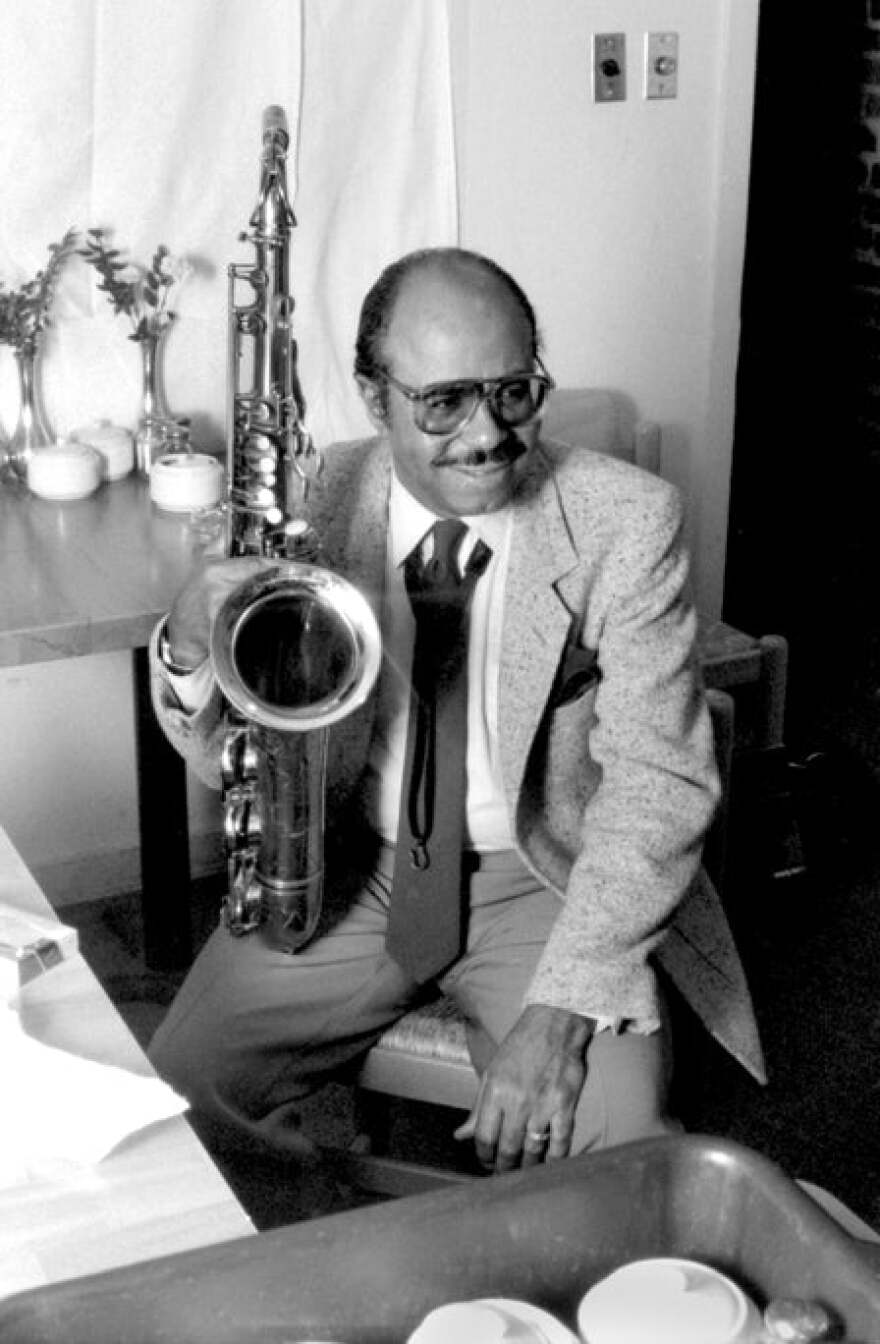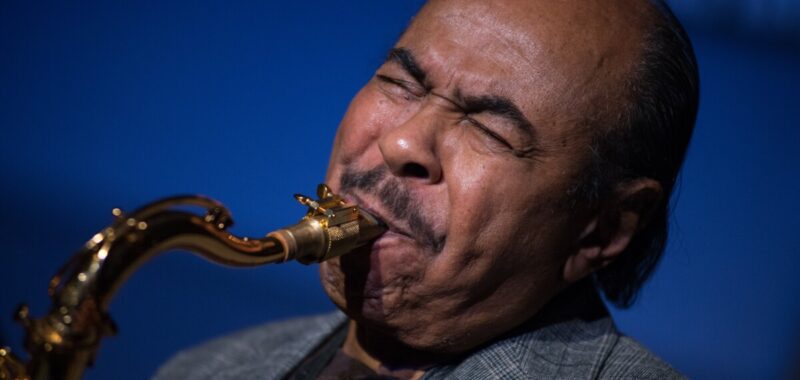Benny Golson, a master saxophonist revered as much for the durable standards he contributed to the jazz repertoire as for his eloquent tenor sound, died on Saturday at his home in Manhattan. He was 95.
His longtime manager and agent, Jason Franklin, said he died after a short illness.
Golson played an integral role in the transition from bebop to hard bop through his short but vital tenure with Art Blakey’s Jazz Messengers, and with his own influential Jazztet, co-led by trumpeter Art Farmer. But his place in the jazz pantheon would be secure even if he had never played a note. Few jazz musicians can claim as many bona fide standards to their credit: bedrock compositions like “Whisper Not,” “Stablemates,” “I Remember Clifford,” “Along Came Betty,” “Killer Joe,” and “Blues March.”
“Every stroke of his pen became another classic,” trumpeter Eddie Henderson, a member of one of his bands, tells WRTI. “His signature sound was undeniable: he could play one note and you knew it was Benny Golson. That’s the mark of a true artist.”
Along with Sonny Rollins, Golson was one of the last two surviving musicians captured in Art Kane’s famed 1958 photograph known as “A Great Day in Harlem.” That image played a crucial role in Steven Spielberg’s 2004 film The Terminal, starring Tom Hanks, in which Golson appeared as himself in a brief but climactic cameo.
Golson was a flowery conversationalist whose extemporizing flowed with the stylish prose and erudition of a master orator. His voice on tenor reflected that sophistication, cultivating bebop lines with a refined polish. He carried that ability into his memorable compositions, which could outline a defined character or tell a captivating story.
“I had a love affair with melodies,” Golson told me in 2007. “As far as I’m concerned, my music should always, now and then, have meaningful melodic content, something you come away humming. Athleticism doesn’t really mean anything. It shows that you can do calisthenics, but nobody can hum any of that stuff. I’m from the old school, I guess.”
Born in Philadelphia on Jan. 25, 1929, Benny Golson was the only child of Celadia, a seamstress, and Bennie Golson, who worked for Nabisco and the Philadelphia Gas Company. While a student at Benjamin Franklin High School, the budding saxophonist came of age alongside an unusually brilliant cadre of musical friends. His peer group included Jimmy and Percy Heath, Red Garland, Philly Joe Jones, Ray Bryant, and his closest friend, John Coltrane.
He recalled that he and Coltrane would frequent North Philly jam sessions together, Trane emulating Johnny Hodges and Golson striving to mimic Arnett Cobb, whose solo on Lionel Hampton’s “Flying Home” at a 1943 Earle Theater performance had changed his life.
Their destinies were altered again a few years later when the bebop innovations of Charlie Parker and Dizzy Gillespie irrevocably reshaped the jazz landscape. Golson recalled: “We were neophytes changing horses in the middle of a stream, trying to play the old music and now, as amateurs, trying to change to the new music. Boy, that was a challenge. But we loved it.”
At his mother’s insistence, Golson attended Howard University, where he got his first experience as a composer and arranger writing for an off-campus jazz band. After graduation he joined a progression of high-profile bandleaders: Tadd Dameron (who he singled out as his greatest compositional influence), Bull Moose Jackson, Lionel Hampton, Earl Bostic, Dizzy Gillespie.
He spent less than a year in Blakey’s Jazz Messengers, alongside several fellow Philadelphians: Lee Morgan, Bobby Timmons and Jymie Merritt. However brief, that stint resulted in the 1958 Blue Note album Moanin’, featuring three soon-to-be classic compositions: “Along Came Betty,” “Blues March,” and “Are You Real.”
The following year, Golson devised the idea of forming a working sextet, and called Farmer, who had been thinking along similar lines. The new band’s 1960 debut, Meet the Jazztet, featured trombonist Curtis Fuller and a young pianist named McCoy Tyner, who would leave after six months to join Coltrane’s quartet. Over the next few years the ever-shifting Jazztet lineup would include Cedar Walton, Grachan Moncur III and Tootie Heath, among others.
The Jazztet’s inaugural run at The Five Spot in Greenwich Village, in 1959, had been a co-bill with free-jazz trailblazer Ornette Coleman, whose east coast premiere became a cause célèbre. Golson was less than impressed, and his attitude regarding the avant-garde never changed. “We intuitively think that change means for the better,” he said. “But sometimes things change and they’re not as good as the things that they evolve from. Sometimes people get so efficient that they’re deficient.”

Brian McMillen
/
Henri Selmer Paris
The Jazztet disbanded for the first time in 1962, when Golson embarked for Hollywood to focus on composing and arranging for television. For more than a decade he disappeared from the jazz world while garnering extensive credits on shows like M*A*S*H, Mission: Impossible, Mannix, and The Partridge Family. He finally decided on a comeback in the mid-1970s.
“I thought I’d never play again,” he said. “I didn’t want to be viewed as a jazz musician [in Hollywood]. I wanted to do comedy and drama, not just ‘hip jazz things.’ So I turned down every gig and eventually they stopped calling. My bridges were burned out of existence… Trying to come back was like getting over a stroke. I wasn’t the same person, and my concept had intuitively changed. It took me ten years to feel comfortable again.”
In 1982 Golson and Farmer reformed the Jazztet with Fuller on trombone, releasing a series of albums through the remainder of the decade that resonated with the revivalist mindset of the rising Young Lions movement.
Following Farmer’s death in 1999, Golson assembled a third version of the band, the New’tet, with Eddie Henderson on trumpet, Steve Davis on trombone, and Golson’s regular rhythm section of pianist Mike LeDonne, bassist Buster Williams, and drummer Carl Allen.
Trumpeter Terell Stafford filled in for Farmer on occasion during this second Jazztet era. “Benny Golson is an incredible icon in this music, but I still think he’s underrated in so many ways,” Stafford tells WRTI. “I always tell my students, ‘If you really want to know the tenor saxophone, start by transcribing Benny Golson.’ So much music and so much harmony come out of his horn, and his songs sound so beautiful while being so complex.”

This past May, that same edition of the Jazztet, joined by saxophonist Bill Pierce, reunited to pay homage to Golson at Smoke Jazz Club in New York. Another member of the band, Steve Davis, attests: “His music is so regal. It requires you to find the essential thing in the changes when you’re soloing or in the phrasing of the melodies. He belongs in the pantheon with Horace Silver, Wayne Shorter, Cedar Walton — the great composers of modern jazz.”
Golson was named an NEA Jazz Master in 1996. He also received a 1994 Guggenheim Fellowship and the 2007 Mellon Living Legend Legacy Award. A documentary film, Benny Golson: Going Beyond the Horizon, is forthcoming; Franklin, his manager, says he saw a full cut of the film a few weeks ago.
Until the documentary’s release, Golson’s best-known appearance on film remains The Terminal. That movie stars Tom Hanks as a man from an unnamed Eastern European country who becomes stranded at JFK Airport during a personal pilgrimage — an attempt to obtain Golson’s autograph on his father’s copy of Art Kane’s famous photograph.
Speaking in 2007, Golson lamented how many of his colleagues from that famed image were gone. “Time is corrosive, but time can be very rewarding sometimes,” he reflected. “Life is full of surprises, disappointments, and rewards… How much time do I have on Earth? There’s no guarantee, because the future’s always going to have an indistinguishable face. We’re not prescient, but to some extent we can give it a face of our own making.”

